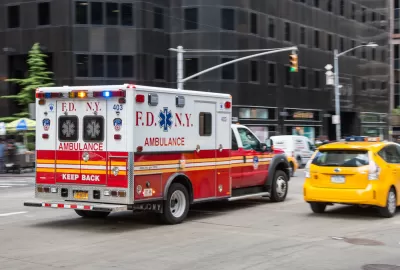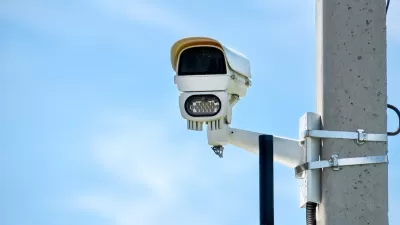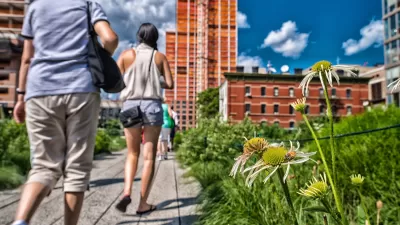Are the needs of emergency response vehicles inconsistent with nondrivers’ needs for slower, safer streets? Maybe not.

One common argument against efforts to create street space for bicycles and other nondrivers is that emergency response vehicles such as ambulances need to drive very fast in case someone has a heart attack, and that therefore all streets should be as wide as possible so that ambulances can drive as fast as 100 miles per hour. But wide streets create a variety of negative side effects: by facilitating fast automotive traffic, they increase the number of fatal crashes, since a car hitting a pedestrian (or another driver) at 50 miles an hour is more likely to cause death than a car traveling 20 miles per hour. In addition, wider streets, by facilitating fast traffic, also encourage long commutes, thus increasing suburban sprawl, which in turn increases vehicle miles traveled and a wide variety of other vehicle-related externalities such as increased greenhouse gas emissions.
Thus, the “emergency response” argument in favor of wide streets only makes sense if the risk of death from a too-slow ambulance outweighs the risk of death from a speeding car. Since over 40,000 Americans died in car crashes last year, this claim seems hard to believe.
But even if this were the case, the needs of emergency vehicles do not support American street design policies that encourage wide roads, fast traffic, and suburban sprawl. Why? Because if we really wanted to get other cars out of the way of ambulances, we would minimize vehicle miles traveled. For example, let’s suppose that instead of extending 50 or 60 miles from downtown, metropolitan Atlanta’s 6 million people lived at Manhattan densities (averaging about 70,000 people per square mile) and lived on narrower, more walkable streets. If this was the case, all of metro Atlanta would fit into an area slightly smaller than Brooklyn (97 square miles). Presumably, traffic would move more slowly, which would be bad for ambulances. So at first glance, it might seem that our hypothetical Atlanta would be far worse for ambulance service than the status quo.
On the other hand, in this scenario, more people would walk or use public transit, so ambulances would not have to compete with as many cars for street space. (Admittedly, they would have to compete with walkers and cyclists—but these groups take up less street space than cars). More importantly, ambulances would not have to travel nearly as far: a quick look at a map of Brooklyn suggests that no one lives more than a mile or two from the nearest hospital. By contrast, in some Atlanta exurbs, the nearest hospital is nine or ten miles away. So the time ambulances would lose in speed they would gain in reduced distance.
Moreover, if we really want to protect ambulances from being slowed down by automobiles, we might want to keep the rest of the citizenry out of cars by giving them other ways of getting around, such as subways and bike lanes. Here, the needs of ambulances are actually consistent with the needs of nondrivers.
Similarly, if we really wanted to make ambulances fast, we wouldn’t have a street network that looks like that of a typical Sun Belt suburb. In many newer suburbs, nearly all residential streets are cul-de-sacs. As a result, most automobile traffic is funneled into a few major commercial streets, thus making those streets unnecessarily congested.
If we really wanted to speed up ambulances, we would put residential streets on a grid, so that ambulances could avoid motorists who were trying to reach offices and stores. Here too, the needs of ambulances are consistent with the needs of nondrivers: with gridded streets, people who want to reach one residential street from another residential street should be able to walk between those streets without having to go to a congested, high-speed commercial street.
In sum, it is occasionally argued that the needs of ambulances are inconsistent with the needs of nondrivers, because ambulances benefit from fast traffic, and nondrivers are safer with slow traffic. But in fact, the interests of ambulance drivers and nondrivers may not be so far apart.

Planetizen Federal Action Tracker
A weekly monitor of how Trump’s orders and actions are impacting planners and planning in America.

Congressman Proposes Bill to Rename DC Metro “Trump Train”
The Make Autorail Great Again Act would withhold federal funding to the system until the Washington Metropolitan Area Transit Authority (WMATA), rebrands as the Washington Metropolitan Authority for Greater Access (WMAGA).

The Simple Legislative Tool Transforming Vacant Downtowns
In California, Michigan and Georgia, an easy win is bringing dollars — and delight — back to city centers.

The States Losing Rural Delivery Rooms at an Alarming Pace
In some states, as few as 9% of rural hospitals still deliver babies. As a result, rising pre-term births, no adequate pre-term care and "harrowing" close calls are a growing reality.

The Small South Asian Republic Going all in on EVs
Thanks to one simple policy change less than five years ago, 65% of new cars in this Himalayan country are now electric.

DC Backpedals on Bike Lane Protection, Swaps Barriers for Paint
Citing aesthetic concerns, the city is removing the concrete barriers and flexposts that once separated Arizona Avenue cyclists from motor vehicles.
Urban Design for Planners 1: Software Tools
This six-course series explores essential urban design concepts using open source software and equips planners with the tools they need to participate fully in the urban design process.
Planning for Universal Design
Learn the tools for implementing Universal Design in planning regulations.
Smith Gee Studio
City of Charlotte
City of Camden Redevelopment Agency
City of Astoria
Transportation Research & Education Center (TREC) at Portland State University
US High Speed Rail Association
City of Camden Redevelopment Agency
Municipality of Princeton (NJ)






























